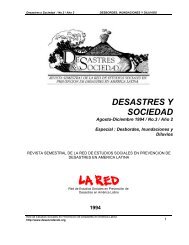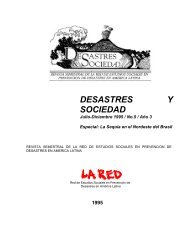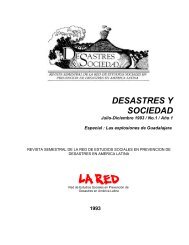Estrategias sociales de prevención y adaptación Social ... - La RED
Estrategias sociales de prevención y adaptación Social ... - La RED
Estrategias sociales de prevención y adaptación Social ... - La RED
You also want an ePaper? Increase the reach of your titles
YUMPU automatically turns print PDFs into web optimized ePapers that Google loves.
ed to inva<strong>de</strong> the Netherlands. <strong>La</strong>rge tracts of land were<br />
sacrificed to stop foreign armies in their tracks. Any foreign<br />
ships would be fen<strong>de</strong>d off with very shallow (flat)<br />
craft. This was integrated into a plan for a series of fortresses<br />
to protect the Dutch towns, the New Dutch<br />
Water Defence Line, running from the Zuy<strong>de</strong>r Zee<br />
down to the Biesbosch wetland, and implemented in the<br />
mid-19th century. Inundation for <strong>de</strong>fence purposes was<br />
practiced in all major wars until the Second World War<br />
against German tanks – in vain, as by then air-power<br />
had become <strong>de</strong>cisive in warfare proving the point that<br />
we have a ten<strong>de</strong>ncy to prepare for the last war rather<br />
than the next.<br />
In<strong>de</strong>ed, on the river Ijssel, the Ijssellinie <strong>de</strong>fence line<br />
was built after 1953 to stop Russian tanks, as if the Soviets<br />
did not have air power. Again land set asi<strong>de</strong> for<br />
inundation. In 1962/3, during the Cuba Crisis, the first<br />
part of the plan was initiated: closing the sluice gates<br />
(Duineveld et al., 2004). It is this <strong>de</strong>fence line that is<br />
being revived as the New Water Defence Line.<br />
Mui<strong>de</strong>n<br />
Weesp<br />
IJsselstein<br />
Lek<br />
Boven-<br />
Merwe<strong>de</strong><br />
Utrecht<br />
Vianen<br />
Asperen<br />
IJsselmeer<br />
Naar<strong>de</strong>n<br />
Hilversum<br />
Waal<br />
Fort bij<br />
Rijnauwen<br />
Houtense<br />
Viakte<br />
Culemborg<br />
Fig. 1.3. The water <strong>de</strong>fence line.<br />
Dike reinforcement and <strong>de</strong>lta dikes. It is clear that the above example is only a “simulacrum”<br />
of a real <strong>de</strong>fence line, and therefore not really a “best practice” as such. This is different<br />
for the other examples in this paper.<br />
Dikes, for example, seemed to go out of style in the early 1990s, but were revived in the<br />
form of emergency dikes (“ka<strong>de</strong>n”) after the 1995 event. The year 2005 proved a particularly<br />
good year for dikes too when Hurricane Katrina floo<strong>de</strong>d New Orleans. While the Dutch<br />
were busy “making space for the river”, they exported the dike technology, for all its flaws,<br />
to the US. The US had long said goodbye to levees, making space for institutional reforms<br />
such as <strong>de</strong>velopmental zoning. Katrina ma<strong>de</strong> the Americans regret the poor state of their<br />
flood <strong>de</strong>fences. Thus, as the Dutch pendulum swung away from dikes, the American pendulum<br />
swung back.<br />
However in a country where space is as scarce as it is in the Netherlands, the taking of<br />
space is likely to be controversial. A more recent case of protesting citizens is the “Brakel <strong>de</strong>bacle”<br />
of 1980. Dike reinforcement is part of the Delta Plan would imply the <strong>de</strong>struction of<br />
picturesque dike houses in the town of Brakel, Gel<strong>de</strong>rland. While new, more context-friendly<br />
types of dikes were recommen<strong>de</strong>d by the Commissie-Becht of 1977, water boards resisted<br />
the concept (van Meurs, 1995). Environmental consciousness led to protests in the Southern<br />
town of Brakel (Brabant), near the historic Loevestein castle. In a series of protests, citizens<br />
contested plans for dike reinforcement in 1980’s as it threatened old dike houses and natural<br />
values. The national water <strong>de</strong>partment respon<strong>de</strong>d by recruiting more and more incorporating<br />
“green engineers” from the ranks of their critics, and pri<strong>de</strong>d themselves on the culture<br />
35

















